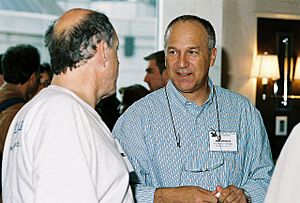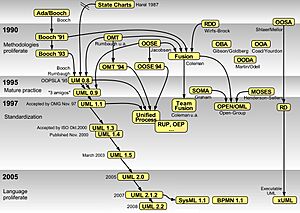David Harel facts for kids
Quick facts for kids
David Harel
|
|
|---|---|
| דוד הראל | |

David Harel (right) with Carl Hewitt at FLoC 2006
|
|
| Born | 12 April 1950 London, England, UK
|
| Nationality | Israeli and British |
| Awards | |
| Scientific career | |
| Fields | Computer science |
| Institutions | Weizmann Institute |
| Thesis | Logics of Programs: Axiomatics and Descriptive Power (1978) |
| Doctoral advisor | Vaughan Pratt |
| Doctoral students | David Peleg |
David Harel (born April 12, 1950) is a very important computer scientist. He is currently the President of the Israel Academy of Sciences and Humanities. Since 1980, he has worked at the Weizmann Institute of Science in Israel. He holds a special teaching position there called the William Sussman Professorial Chair of Mathematics. David Harel was born in London, England. He also served as the Dean of the Faculty of Mathematics and Computer Science at the Weizmann Institute for seven years.
Contents
About David Harel's Work
David Harel is famous for his work in several areas of computer science. These include how computers think (called dynamic logic) and what computers can actually do (called computability). He also worked on how to store and find information (database theory).
Software Engineering and Modeling
One of his biggest achievements was inventing a visual language called Statecharts in the 1980s. This language helps people design and program computer systems that react to things happening around them. Statecharts became a part of a widely used standard called UML.
Later, in the late 1990s, he focused on a new way to program these systems. This method uses "scenarios," which are like step-by-step stories of how a system should work. He helped create something called Live Sequence Charts for this purpose.
Explaining Computer Science
David Harel has also written books to help people understand computer science. His book "Algorithmics: The Spirit of Computing" won an award in 1987. In 2000, he wrote "Computers Ltd.: What They Really Can’t do." He even presented computer science topics on Israeli radio and television.
He has explored many other interesting topics too. These include how to arrange diagrams neatly (called graph layout) and how to teach computer science. He also studies how to create computer models of living things and how to understand and share information about smells.
Education and Contributions
David Harel earned his PhD from MIT between 1976 and 1978. In 1987, he helped start a software company called I-Logix. This company later became part of IBM in 2006.
He has also suggested building a complete computer model of a tiny worm called Caenorhabditis elegans. This worm was the first animal to have all of its genetic information mapped out. He believes that completing such a model depends on his updated idea of the Turing test. The Turing test is a way to see if a machine can think like a human.
David Harel is a respected member of many important groups. These include the ACM, the IEEE, and the AAAS. He is also involved in groups that work for peace and human rights in Israel.
Awards and Recognitions
David Harel has received many awards and honors for his important work. Here are some of them:
- 1986: Stevens Award for Software Development Methods
- 1992: ACM Karlstrom Outstanding Educator Award
- 1994: Became an ACM Fellow
- 1995: Became an IEEE Fellow
- 2004: Received the Israel Prize for computer science, which is a very high honor in Israel.
- 2005: Received an honorary doctorate from the University of Rennes, France.
- 2006: Received the ACM SIGSOFT Outstanding Research Award.
- 2006: Became a member of the Academia Europaea.
- 2006: Received another honorary doctorate from the University of Milano-Bicocca.
- 2006: Became an honorary fellow of the Open University of Israel.
- 2007: Received the ACM Software System Award.
- 2010: Received the Emet Prize.
- 2010: Became a member of the Israel Academy of Sciences and Humanities.
- 2012: Received an honorary doctorate from Eindhoven University of Technology, The Netherlands.
- 2014: Became an International Member of the US National Academy of Engineering.
- 2014: Became an International Honorary Member of the American Academy of Arts and Sciences.
- 2019: Became an International Member of the US National Academy of Sciences.
- 2020: Became a Fellow of the Royal Society (FRS), a very prestigious scientific group in the UK.
- 2021: Became a Foreign Member of the Chinese Academy of Sciences.
- 2023: Received the Harlan D. Mills Award.
More Information
- List of Israel Prize recipients
- Members of the Israel Academy of Sciences and Humanities


